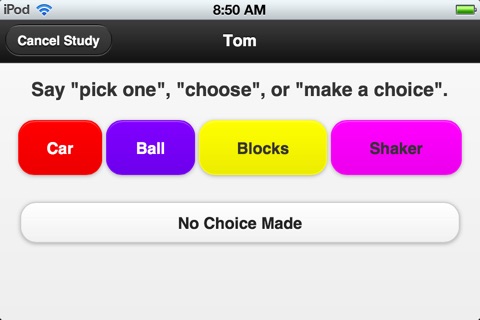
Preference Assessment app for iPhone and iPad
Developer: Touch Autism
First release : 01 Jun 2011
App size: 2.35 Mb
This Preference (Reinforcer) Assessment app was designed by a BCBA (board certified behavior analyst) to make running a preference (reinforcer) assessment amazingly easy to do, so that anyone can effectively and scientifically determine their child’s or client’s preferences.
This app includes such features as descriptions of all of the types of preference assessments, a timer to determine the end of a trial, a timer to indicate how long each item is engaged with, the ability to assign a color to each item, the ability to customize each assessment type and specific instructions and visuals to help you set up and run the assessment.
Once the assessment is finished the app will automatically calculate the percentage of times each item was selected in which it was available, and will present this info in an easy to read bar graph. The data and graph from each client will be saved on the app, so that the user can easily review results from past assessments.
Reinforcement (Preference) Assessments are an incredibly important procedure in any behavior change program. They are not conducted nearly as often as they should be because they can be difficult to run, or because many parents, caregivers or practitioners have not been sufficiently trained to run them.
A preference, or reinforcer assessment is one of the key components of a BIP (behavior intervention plan) or FBA (functional behavior assessment). To effectively strengthen a target behavior a caregiver must know which items or activities will act as the strongest reinforcers. Additionally, research has shown that caregiver and even self-report are not always the best indicators of actual preferences. Preferences, or suitability of different reinforcers often shift over time, so it’s imperative to continually perform preference assessments to make sure the stimuli you are using are still acting as effective reinforcers.
Studies have shown that parents and caregivers opinions or beliefs of what a client/child prefers are often not as reliable as the results from a systematic preference assessment. Specifically one study found a near zero correlation to what was chosen via a preference assessment and what was predicted by caregivers (Green, Reid, White, Halford, Brittain, & Gardner 1988).
Additionally a study conducted with nine preschoolers with developmental disabilities found that systematic assessment identified more effective reinforcers than the teacher survey (Cote, Thompson, Hanley, & McKerchar 2007).
In summation, it was been repeatedly shown that the correlation between what parents/caregivers think is a reinforcer and what actually functions as a reinforcer is near zero for some individuals.
This app is based on the principles of a scientific preference assessment as described in the 1996 article published in the Journal of Applied Behavior Analysis by DeLeon, I. G., & Iwata, B. A. “Evaluation of a multiple stimulus presentation format for assessing reinforcer preferences” 29, 519-533.



